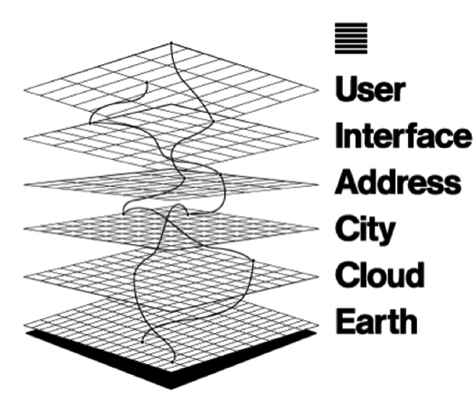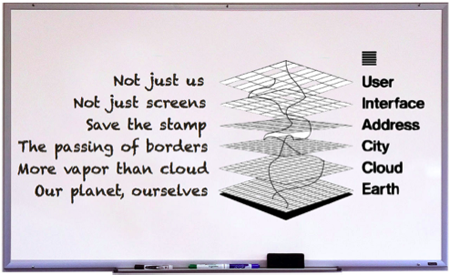Authors: David Fore
Posted: Wed, August 03, 2016 - 4:18:39
From that phantom vibration to that reflex to grab your own rear, you are responding to the call of The Stack…
From the virtual caliphate of ISIS to the first Sino-Google War of 2009 to the perpetually pending Marketplace Fairness Act, The Stack gives birth to new sovereignties even as it strangles others in their sleep.
From YouTube’s content guidelines to Facebook’s news algorithm to Amazon’s invisible hand, The Stack promulgates de facto cultural, legal, and economic norms, transforming conventional borders into well-worn cheesecloth.
From @RealDonaldTrump’s hostile takeover of the GOP to all those hand-wavy pretexts for Brexit, The Stack scrambles party politics by offering peer-to-peer loyalties, fungible citizenship, royalty-free political franchises, and 24/7 global platforms… all for the price of a moment of your time.
From mining coal to rare earth to bitcoins, The Stack wrangles the resources to fuel itself—and hence ourselves—even if at the price of planetary autophagia.
From the Internet that got us [1] this far to the neo-internets coming online to splinter and consolidate perceptions, fiefdoms, and freedoms, The Stack is reaching a new inflection point.
From earth to Cloud to City to Address to Interface to User, Your Permanent Record is enacted, assembled, stored, distributed, accessed, and made into meaning by means of The Stack.
The Stack had no name, not until Benjamin Bratton borrowed the term from computational architecture, capitalized it, then applied it to this techno-geo-social architecture we call home. It’s also the title of his new book published by MIT Press: The Stack: On Software and Sovereignty.
The book delineates the hockey-stick ascent of digital networking from its early identity as a narrowly defined instrument made and used by government and military types to its central role in creating a planetary organ of cognition, composition, dissolution, and transformation. In a startlingly short time we see digital systems of computation, communication, feedback, and control emerging as our species’ system of systems.
Fleshy and rocky, pixelated and political, The Stack is every bit as consequential as climate, geology, society, and other sister systems of planetary activity. Promiscuous by nature, The Stack invites most anything and excludes virtually nothing. It connects us and completes us, rendering the world visible even as it pins us to our place like butterflies to a board. Acknowledging absence as much as presence, The Stack serves as an automagically accommodating host that anticipates, invents, and activates urges, ideas, and outcomes. We leverage The Stack not just because we want to, but because by signing the Terms of Use we are feeding The Stack’s own capacious memory and so informing its actions.
Convenience and benefit is where the line blurs between user and used.
Not simply a host, The Stack is also a parasite that renders us into its host. The physics of exchange are simple; the terms of human exchange less so. But a deal is a deal.
So immense as to hide out in plain sight, The Stack was designed and built by nobody—not knowingly, at any rate, and certainly not all of it. Still nobody is in charge of its uses, its reach, or its fate; except maybe each of us as we use The Stack to extend our reach to realize our fates. The Stack will oblige by responding in kind.
But really what is the The Stack? To start with, this is not your father’s Internet. Instead, the Stack is a consolidated six-layer meta-platform we can use as an “engine for thinking and building.” It is also a “conceptual model” with which we might apprehend the “coherent totality” of this “technical arrangement of planetary computation.” Bratton’s book lays out the former in service of the latter.
For some readers, The Stack will stand shoulder-to-shoulder with Christopher Alexander’s pattern language tomes, particularly A Timeless Way of Building. Like Alexander, Bratton is deeply committed to identifying patterns in human-made structures and how they support, subsume, and define our humanity and the viability of the world itself. Both writers view citizens as potential architect/builders with an inherent right to program the spaces they inhabit. They both take a fundamentally ecosystemic view of the project of design, construction, and use.
But writers are stylists, though of very distinct stripes. Alexander can wax poetic, composing his prose to a faintly mystical beat; he rarely cites sources, and there is a messianic slant to his historiography. For all of that, perhaps, Alexander is much loved by readers, whether laypeople or professionals. Bratton, by contrast, crafts intricate prose, employs diction as concrete as his subject is abstract, and deeply sources his inspirations. His worldview, meanwhile, is assiduously non-deterministic. For all that, we shall see how broadly Bratton’s work will be embraced by intellectual, practitioner, and civilian readerships.
Each sentence of The Stack is packed as tight as a Tokyo subway train, forcing the willing reader to double-back to pick up what Bratton lays down. The payoff can be thrilling, much like watching the brain-bending eloquence of Cirque de Soleil. Bratton’s wit shines through most every page, in forms both dry and waggish, offering the dyspeptic reader means to metabolize the book’s quarter-million words [2].
But why a “stack”?
Traditionally, a technology stack comprises hardware and software that runs stuff, with storage servers situated toward the bottom and end-user applications toward the top. Companies, however, tend to overvalue the layer of the stack in which they operate, and they undervalue those above. Bratton’s schema takes air out of the tires of blinkered business models, blanched political projections, and pell-mell individual attempts to make change. The Stack he sees in his mind’s eye runs this gamut and much more. He abstracts application and data elements, replacing them with Cloud, City, and Address, thereby emphasizing the technical, jurisdictional, and identity functions at the heart of The Stack’s raison d’être. Bratton goes on to cap The Stack top and bottom with a pair of layers — User and Earth — typically ignored by technical stacks. The Interface, meanwhile, abides… even if Bratton’s idea of interface is less digital and more architectural than most writers attach to that word [3].
So I’m, like, a designer, right? I’d expect that such a designery book would employ scads of visualized designery designs to sell its suds. Well, I have a warning for readers panting for designporn: The Stack will leave you high and dry. Bratton is crafting an argument here, something never won without words. Indeed, there’s just a single image, found on p. 66:

In eschewing complex graphical explications, Bratton’s overt bookmanship serves his project. The Stack hexagram lends structural clarity, metaphoric utility, and conceptual coherence that might fertilize bountiful discussions about this most systematic of unsystems whose workings we sense but whose totality we never quite glimpse.
To name The Stack is to make it visible and therefore subject to interpretation, critique, and use [4]. In any event, Bratton’s six-layer hexagram [5] is not simply a simplification, some kind of user-friendly rhetorical strategy for making his ideas more digestible. Rather (or in addition to) digestibility, it is a concrete logos that we — makers, theorists, political disrupters, web monkeys, app-slingers, and armchair academics alike — can use to better focus our meditations and actions. There is a portability to it that I quite like. I can easily hoist these ideas up on a whiteboard for my comrades and I to grok its gestalt and locate opportunities to investigate our own particular professional, personal, aesthetic, ethical, and political interests:

In delaminating and delineating each layer’s position, constituents, relationships, and purpose, Bratton’s hexagram helps us see beyond the shibboleths of the-Internet-as-cash-machine, Internet-as-thought-control-machine, Internet-as-Leviathan, and Internet-as-Heaven’s Gate. And that’s a good thing. After all, while the Internet (or now, according to a recent update to The New York Times’ style guide, “the internet”) has provided many of the platforms on which The Stack depends, this accidental megastructure is something far more complex, powerful, and new than all that. Between its great potential and uncertain future, The Stack is still a bit of an ingénue. Put in motion, The Stack is manifesting emergent orders that amount to an asymptotic identity: always approaching but never arriving at a perceptible resolution. We can help it come clean and grow up.
By considering The Stack as a whole, this book better equips us to contend with this “accidental geodesign that demands from us further, better deliberative geodesign.” When the world itself is seen as information, in other words, the task of organizing all the information is the same as organizing all the world. The map becomes the territory, which renders the converse true, too.
While many aspects of The Stack were the result of deliberate planning, The Stack as a whole was neither conceived nor constructed to envelop and subsume the planet. The notion that the Stack is a planetary sensing/cognition/connection/control system that we unintentionally midwifed is repeatedly emphasized by Bratton. But does that imply that something like mindful action might make a difference here? Indeed, The Stack can seem as resistant to comprehension and design as a hurricane is resistant to science and prayer. A palpable urgency infuses Bratton’s breakneck prose, perhaps reflecting his view that The Stack is already crafting politics, geography, and territory in its own image, with modes of governance that enforce themselves. Indeed, as the press is atwitter with visions of robot armies cresting the hill, we would do well to ensure that the substantive contributions we make to The Stack now will constitute kernels of its ultimate operations. Falling short of that goal will leave us watching our ideas and ideals slip away into quaint and ultimately orphan code, commented out by other better, synthetic minds than our own.
Then should we then just buy sandbags, hunker down, and sweep up after? The prospect of us being stalked by Skynet strongmen seems no more likely to Bratton than the arrival of machines of loving grace foretold by the poet [6]. The flipping toast might just as well land butter-side up as down; we really won’t know until the final instant. In the meantime, we might seize the opportunity and means to do what we can to flip it our way. Will we measure up to the challenge? By positing a coherent totality for The Stack, Bratton offers a perch from which we might exercise influence over the profound and protean implications of our reliance upon, and responsibilities for, The Stack.
Finally what comes to mind is the musical question [7] posed by Jacob Bronowski, in his book Science and Human Values, as he drove toward Hiroshima in August 1945:
Is you is or is you ain’t my baby
Maybe baby’s found somebody new
Or is my baby still my baby true.
Endnotes
1. I use “us” in that writerly way (you and me) as well as in reference to our fellow Stackmates, including but not limited to users animal, vegetable, and mineral; connections and desertions tacit and explicit; recherchant industrial processes and ethically confused robots; spam sent by the supply chains in hopes of inspiring our refrigerators to place an order in time for dinner.
2. Thumbnail heuristic evaluation: Even with tiny type and slim margins, the hardbound version of The Stack weighs in at nose-breaking 2.5 pounds. And so while this reader stills consumes books composed of sheets of reconstituted trees bound together by glue and pigmented with ink, I urge safety-minded readers to download the electronic version of this weighty tome. The User does so by activating an Interface at a convenient Address in the City to stream Bratton’s colorful disquisitions from the Cloud, which is on, sometimes below, but always of the Earth. (viz: here)
3. While conception and significance of interfaces will remain non-negligible in my practice, I see the interplay of voice and algorithm gradually rendering interfaces immaterial.
4. The wordfulness of this book also reminds us that the machines comprising The Stack are history’s most inveterate readers; IBM Watson, just to name one, can read 800 million pages per second.
5. For readers following along in their I Ching: we see here hexagram #1: Ch’ien/The Creative.
6. I like to think
(it has to be!)
of a cybernetic ecology
where we are free of our labors
and joined back to nature,
returned to our mammal
brothers and sisters,
and all watched over
by machines of loving grace.
—Richard Brautigan
7. Quoting the much-loved Renne Olstead lyric.
Posted in: on Wed, August 03, 2016 - 4:18:39
David Fore
View All David Fore's Posts






Post Comment
No Comments Found